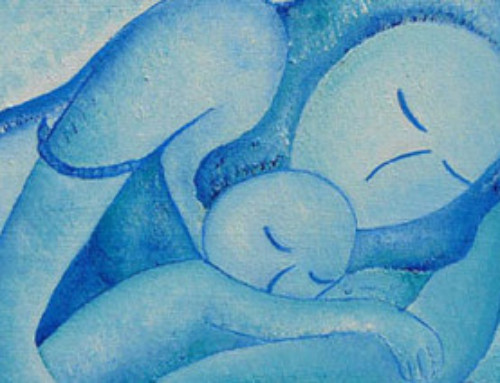You’ve probably heard it a hundred times. Parents talking about their child and why parenting was so hard: He was just such a difficult baby. It’s supposed to explain the frazzled looks, the endless crying, and every other negative trait we attribute to the baby in question. But does it?
What Is This “Difficult” Baby?
There seem to be two types of difficult babies and it is unclear how much they overlap. The first is the difficult baby who cries and fusses most of the time
And this difficult, crying baby is seen as being immovable. People have been putting a ton of weight onto the idea of a child’s temperament being fixed that we’ve never really thought about how we might be affecting that very thing that seems to be so static. The problem with that is that we may be hurting the children who we’re giving these labels to because we’re more likely to propose behaviours that have the potential to do long-term damage. The research on temperament and outcomes highlights a few very important points we need to consider, ones I will address in this two-part series:
1) Temperament may not be as static and ingrained as we believe.
2) Attachment status is a strong predictor of temperament and thus should be taken more seriously than it is.
3) Those children with the “difficult” temperament may be the ones at most risk of negative outcomes from the behaviours we propose for them – and the ones who might benefit the most from other types of behaviours.
When we consider these points and what the research is telling us, I hope it will become clear that these “difficult” children may require a very different type of parenting than we have thus far been given them on the whole.
“My baby was born that way”
The idea of a built-in personality is a view that has been long-held by many. There have been dissenters of this view, namely behaviourists like BF Skinner and John Watson who felt that children were born as a blank slate[2], only to become who they are from experience. But we’ve learned from research that that simply isn’t the case. We’ve also learned, however, that a child’s behaviour is still affected by his or her environment; that is, a child is a product of the mix between the genes she’s born with and the experiences she has growing up. But the question that remains is the degree to which temperament is ingrained. At the moment, people believe that it falls much more on the genetic side rather than experience and in turn remove themselves from the equation in terms of behaviours that may help alleviate this type of “difficult” behaviour. And why not? If you believe that you have no control over your child’s temperament, why would you think to change anything in the way you parent?
The problem with this predominantly ingrained view of behaviour is that there is a relative dearth of research supporting such a view, and in fact, research seems to support the idea that we can have an immense influence on how our children are within reason. So why do we hold this belief? Because much of the research on temperament does show stability across the years, the problem is that the earliest people measure temperament is around four months of age. Anyone who’s a parent can attest that a heck of a lot can happen in four months to shape the way your child behaves, or at least how you perceive and take their behaviour.
What is the research against this ingrained view? For starters, doctors and caregivers are finally starting to acknowledge the role of the sensitivity of infant digestive system when it comes to fussiness, or colic[3]. Many babies have intolerances (or full-blown allergies) to certain food products—dairy, gluten, and soy being the most prominent—and they are exposed to these either through formula or through their mother’s breast milk. A mom’s diet can very readily affect the fussiness of her child and for years, that aspect has been largely ignored in favour of “blaming the child”. (I put it in quotes because I don’t believe people blame in the sense of intentional actions, but the fault is somehow placed on the child, even if the caveat of unintentionality is included.)
But a far more pervasive problem exists that we actually have the capacity to deal with if we accept it. Research has been showing for years that it is maternal characteristics that are more predictive of infant temperament than the infants themselves[4][5][6]. Things like maternal anxiety, low self-esteem, aggressive tendencies, and child-rearing attitudes (including beliefs about responsiveness to the child, spanking, leaving the child to cry-it-out, etc.) measured prenatally were very significant predictors of infant temperament. While it is possible that these genes are passed genetically, it has been more commonly felt (by researchers) that it is the mother’s attitudes towards the child (attitudes developed prenatally) that account for this relationship. Why? Because these mothers, due to their belief system and own personality traits, are more likely to engage in harsh parenting, including the use of physical discipline, and be less able to cope with typical infant behaviours, like crying, and the reason for this may stem from their physiological responses to the everyday issues of parenting. For example, it has been found that mothers who reported they had “difficult” babies had a much stronger and visceral physiological response to an infant’s cry both prenatally and postnatally[6]. While the research is not conclusive on the matter, the fact that these observations are made prior to the arrival of the infant and are predicted by the mother’s child-rearing attitudes speak strongly to the environmental influence of what one perceives to be a “difficult” baby.
What’s important to remember here is that when talking about infant temperament, it’s often not “high needs” but “difficult” that people report on and is of interest in the research. Things like “high needs” are quite real and represent temperament (though sadly not often what is reported on), but the degree to which it’s “difficult” (i.e., associated with lots of crying, distress, etc.) is what may be shaped by maternal behaviours and characteristics. A quick example: My daughter is high needs and has been since birth. Wouldn’t be put down ever, nursed regularly, and needed constant contact; this was her “high needs” behaviours. However, she was also unbelievably happy and I would never have called her “difficult” because I was able to provide her with the behaviours that suited her ingrained personality. Hopefully people keep in mind that what we are talking about here is “difficult” behaviours, but obviously they are often overlapping with “high needs” temperaments as these are the children that get labeled difficult because caregivers do not respond appropriately.
The Role of Attachment
The second problem for the “difficult” child is that they are far more likely to have an insecure relationship with their caregiver than their “easy” counterpart[6][7]. For example, in one particular study of infants classified as either “easy” or “difficult”, 31% of infants who were in a secure relationship with their caregiver were described as “difficult” whereas 100% of infants in an insecure relationship were thus described[6]. Clearly not all insecurely attached infants will be difficult (this one study would be an anomaly), but even when the ratings are looked at on a continuous level, there is a correlation between the easiness of a child and the security of attachment. Of course, correlation does not equal causation and it would be logical to consider that a difficult baby is hard to become securely attached to, but then we have to return to the idea that this notion of “difficult” seems to have more to do with preconceived notions that are in place prior to the birth of the child (which may explain why some difficult babies are very securely attached).
Other researchers have suggested that temperamental distress is reflected in one’s attachment status[8][9]. While originally it was though low distress infants would fall into the secure or insecure-avoidant classifications and high distress (or “difficult”) infants falling into the secure or insecure-resistant classification, research on physiological distress does not support this more basic classification[10]. But that does not mean that attachment is not related to distress. In fact, insecurely attached infants (both subtypes) have been found to demonstrate higher physiological reactions in the Strange Situation test (the objective assessment of attachment) than securely attached children[11][12]. Thus, distress does seem to be related to attachment, just in a different manner than previously thought. These results are now thought to reflect the infant’s failed attempt at coping with a situation[13]. That is, the infant is faced with a threat but because the parent has not formed a relationship that helps the infant cope with these fearful situations, the infant’s cortisol levels continue to rise past what one would expect from a securely attached infant who feels he has a stable base to work with. All infants see most situations as being somewhat threatening—after all, the world is big, new, and kinda scary—and so they rely upon their parents to make the world a little less scary for them. If a child doesn’t have that secure base to latch onto, they can become much more fussy because they continue to see threats and continue to fail to cope with them as they are simply too young and immature to cope with them on their own.
What I found most heartening to read is that even if you’re one of the many parents who is parenting attachment-style and has a secure relationship with your child, but that baby is still “difficult” (you know you’re out there), that secure base you have is helping your child. In work by Megan Gunnar and colleagues, they found that attachment style moderated the relationship between the amount of cortisol an infant released during a stressful situation and his or her temperament[14]. Specifically, the abnormal rise in cortisol was found only in the group of children who were both “difficult” (here labeled “highly fearful” which was based on level of clinginess to mother and distress in social situations, the second type of “difficult” discussed at the start) and had an insecure attachment relationship.
What does all this mean and how does this lead to us doing a disservice to our “difficult” children? Click Here to read Part 2.
[14] Gunnar MR, Brodersen L, Nachmias M, Buss K, Rigatuso J. Stress reactivity and attachment security. Developmental Psychobiology 1996; 29: 191-204.







Why oh why isn’t every new mom taught how to massage her baby? Why isn’t this considered a necessity ahead of the ‘in’ stroller, diaper bag and numerous outfits? It has so many positive advantages in the bonding relationship. The psychological, physical and developmental benefits for mom are incredible and her infant grows in a multitude of areas with every stroke. Yet little to no research is being done in the field here in America. It should be considered a badge of intelligence and baby well-being, to be able to say, “I massaged my baby daily during those crucial first 6 months.” The benefits continue and the bonding lasts a lifetime with dedicated consistency on the caregivers part.
The 4 Distinct Benefits of Infant Massage
Stimulating
Stimulates all the systems of the body to develop efficiently & properly including the:
Nervous system – myelination (speeds signals from body to all parts of the brain)
Circulatory system – aids in reaching all parts of the body & speeds healing
Respiratory System – develops lungs and regulates breathing
Digestive system – decreases incidence of reflux by aiding development of the area of the brain that regulates the opening and closing of the esophageal sphincter at the top of the stomach
Elimination System – regulates the efficiency of nutrients moving thru the tummy & bowels, assuring less gas and colic pain
Immune System – body is able to fight off illnesses better
Stimulates the release of oxytocin, known as the “cuddle” hormone (is released in both parents and child), prolactin (promoting milk production in the mother) and other endorphins (the “feel-good” hormones)
Relaxing
Helps relieve tension built up from the stimulations in baby’s daily environment
Helps babies handle sensory stimulation and respond in a relaxed manner
Reduces muscle stiffness and normalizes muscle tone
Helps babies sleep more easily and deeply
Helps regulate sleep/wake cycle
Relief
Touch, combined with vocalization (soft voice or singing) helps reduce pain levels up to 80%
Helps tone the whole digestive tract, from the esophagus to the large bowel
Helps alleviate gas and promotes elimination
Releases hormones for food absorption
Releases endorphins, natural pain killers, to ease emotional distress
Bonding & Attachment
Enhances verbal & non-verbal communication through ALL the senses
The loving touch of infant massage draws on all the elements included in the bonding and attachment process:
• eye-to-eye contact – skin-to-skin contact – body scent – voice recognition – teaches awareness of ‘proper’ touching – demonstrates responsiveness of parent to baby’s cues, which teaches baby to trust
• releasing of “feel good” hormones in both parent and child
Massage increases a parent’s confidence in their parenting-skills.
Meredith Piscitelli, CEIM
Certified Educator of Infant Massage